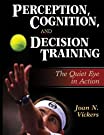by Thomas Kurz
In the previous article you learned how eye focus of sports experts or champions is different from that of nonexperts.
In many sports, being able to correctly focus on a single object (i.e., target) is not enough. One has to simultaneously track multiple objects, such as fast movements of several players and of the ball. That ability to distribute constant attention among many moving objects can be measured and trained, too. There is a tool for it. That tool is NeuroTracker. Instead of writing a lot about it, I invite you to see sample NeuroTracker exercises here:
https://www.neurotrackerx.com/
NeuroTracker benefits athletes of all sports, not just ball players. The multiple objects need not be players on the field. They may be key parts of an opponent’s body. For example, reading simultaneous movements of an opponent’s feet, hips, trunk, head, and shoulders lets a boxer, well, “read” that opponent.
You will get the most benefit from NeuroTracker training if you apply the “quiet eye” technique (see Perception, Cognition, and Decision Training: The Quiet Eye in Action by Joan N. Vickers). If you do it right, you may quickly acquire the ability to track multiple fast-moving objects without consciously concentrating on them. So, for example, while doing a NeuroTracker exercise, you will focus on a certain point with the “quiet eye” and yet, when checked by the program, you will know the position of every object you were supposed to track.
Not making a conscious effort to accurately track multiple fast-moving objects leaves your mind with free processing resources to focus on the main task–passing that ball or throwing that uppercut.
To prepare yourself for both the quiet eye and NeuroTracker training, you may use Gold Medal Mental Workout to learn how to deeply relax, concentrate, and shut out distractions.
This article is based on the book Perception, Cognition, and Decision Training: The Quiet Eye in Action by Joan N. Vickers (2007). Get this book now and have all the info—not just the crumbs! Order now!
If you have any questions on training, you can post them at Stadion’s Sports and Training Discussion Forum.



I am interested in “the gaze” for both boxing and judo. In boxing if I look at a target (chin), then I am attacking. If I look at the hands, then I am defending or reacting. With judo I tend to watch the feet, but because I’m touching my opponent I can react to his movement–I can feel his intended throw without looking. Where do you look for boxing and/or judo?
Lee in NV
BTW I have one of your Umbrellas. Just waiting for it to rain. LOL
Outside of a clinch (so it applies both to boxing and to judo), one should look at the opponent’s upper chest, both in attack and in defense. The upper chest always moves in concert with the limbs–unlike the head, which can do fakes. Further, centering the gaze on the upper chest let’s one perceive motions of the hips and shoulders with peripheral vision. Looking at the hands or feet is defensive (in a bad sense); see page 106 in the book Perception, Cognition, and Decision Training: The Quiet Eye in Action by Joan N. Vickers (2007).
In a clinch one cannot look at the opponent’s upper chest, obviously. Nevertheless, even though in the clinch one relies on the sense of touch, the gaze needs to be fixed on a point (not necessarily on the opponent), which depends on the intended technique. Each technique has a point at which one needs to look in order to execute that technique properly (those points may be similar for several techniques)–look elsewhere and you will mess up. This has to do with the alignment of the whole body, which depends a lot on the position of one’s head, which in turn depends on the direction of the gaze (again, in some techniques one may have to look at something other than the opponent).
BTW, looking at the limbs in fighting is a big error–find better instructors.